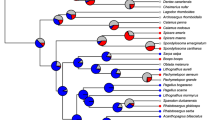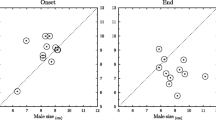Abstract
Considering its immediate costs of producing dispensable males, the maintenance of sexual reproduction is a major paradox in evolutionary biology. Asexual lineages that do not face such costs theoretically should replace sexuals over time. Nonetheless, several systems are known in which closely related sexual and asexual lineages stably coexist. In the present study, we studied a sexual/asexual mating complex of a sperm-dependent parthenogenetic fish (amazon molly, Poecilia formosa) and its sexual congeners, the sailfin molly P. latipinna and the Atlantic molly P. mexicana. We asked whether differences in feeding behavior could contribute to their stable coexistence. We conducted a laboratory experiment to compare feeding efficiencies and also measured the competitive abilities between the two reproductive forms. Additionally, we measured gut fullness of fishes caught in natural habitats. Contrary to our predictions, we could not find P. formosa to be less efficient in feeding. We argue that food competition in mollies plays a minor role in mediating coexistence between closely related asexual and sexual mollies.



Similar content being viewed by others
References
Agrawal AF (2001) Sexual selection and the maintenance of sexual reproduction. Nature 411:692–695
Balsano JS, Abramoff P, Darnell RM (1972) Electrophoretic evidence of triploidy associated with populations of gynogenetic teleost Poecilia formosa. Copeia 1972:292–297
Balsano JS, Randle EJ, Rasch EM, Monaco PJ (1985) Reproductive behavior and the maintenance of all-female Poecilia. Environ Biol Fish 12:251–263
Barton NH, Charlesworth B (1998) Why sex and recombination? Science 281:1986–1990
Bell G (1982) The masterpiece of nature, the evolution and genetics of sexuality. University of California Press, Berkeley
Case TJ, Taper ML (1986) On the coexistence and coevolution of asexual and sexual competitors. Evolution 40:366–387
Darnell RM (1962) Fishes of the Rio Tamesi and related coastal lagoons in east-central Mexico. Publ Inst Mar Sci Univ Tex 8:299–365
Darnell RM, Abramoff P (1968) Distribution of the gynogenetic fish Poecilia formosa with remarks on the evolution of the species. Copeia 354–361
Fischer C, Schlupp I (2010) Feeding rates in the sailfin mollie Poecilia latipinna and its coexisting sexual parasite, the gynogenetic Amazon mollie Poecilia formosa. J Fish Biol 77:285–291
Gabor C, Ryan MJ (2001) Geographical variation in reproductive character displacement in mate choice by male sailfin mollies. Proc R Soc Lond B 268:1063–1070
Gray M, Weeks S (2001) Niche breadth in clonal and asexual fish (Poeciliopsis): a test of the frozen niche variation model. Can J Fish Aquat Sci 58:1313–1318
Heubel KU, Plath M (2008) Influence of male harassment and female competition on female feeding behaviour in a sexual-asexual mating complex of mollies (Poecilia mexicana, P. formosa). Behav Ecol Sociobiol 62:1689–1699
Hubbs C (1964) Interactions between a bisexual fish species and its gynogenetic sexual parasite. Bull Tex Mem Mus 8:1–72
Hubbs C, Hubbs LC (1932) Apparent parthenogenesis in nature in a form of fish of hybrid origin. Science 76:628–630
Hubbs C, Kuehne RA, Ball JC (1953) The Fishes of the upper Guadelupe River, Texas. Tex J Sci 2:216–244
Jokela J, Dybdahl MF, Lively CM (2009) The maintenance of sex, clonal dynamics, and host-parasite coevolution in a mixed population of sexual and asexual snails. Am Nat 174:S43–53
Kallman KD (1962) Population genetics of the gynogenetic Teleost, Mollienesia formosa (Girard). Evolution 16:497–504
Kokko H, Heubel KU, Rankin DJ (2008) How populations persist when asexuality requires sex: the spatial dynamics of coping with sperm parasites. Proc R Soc Lond B 275:817–825
Ladle RJ (1992) Parasites and sex: catching the Red Queen. Trends Ecol Evol 7:405–408
Lampert KP, Schartl M (2008) The origin and evolution of a unisexual hybrid: Poecilia formosa. Philos Trans R Soc Lond, B 363:2901–2909
Lively C, Lloyd D (1990) The cost of biparental sex under individual selection. Am Nat 135:489–500
Maynard Smith J (1978) The evolution of sex. Cambridge University Press, Cambridge, USA
Miller RR (1983) Checklist and key to the mollies of Mexico (Pisces, Poeciliidae, Poecilia, Subgenus Mollienesia). Copeia 817–822
Moore WS, McKay FE (1971) Coexistence in unisexual-bisexual species complexes of Poeciliopsis (Pisces: Poeciliidae). Ecology 52:791–799
Moyle PB, Light T (1996) Biological invasions of fresh water: empirical rules and assembly theory. Biol Conserv 78:149–161
Niemeitz A, Kreutzfeldt R, Schartl M, Schlupp I (2002) Male mating behaviour of a molly, Poecilia latipunctata: a third host for the sperm-dependent Amazon molly, Poecilia formosa. Acta Ethol 5:45–49
Padur L, Wedekind J, Öztürk Ö, Streit B, Tiedemann R, Plath M (2009) Do audience effect lead to relaxed male sexual harassment? Behaviour 146:1739–1758
Parzefall J (1969) Zur vergleichenden Ethologie verschiedener Mollienesia-Arten einschliesslich einer Höhlenform von M. sphenops. Behaviour 33:1–37
Parzefall J (2001) A review of morphological and behavioural changes in the cave molly, Poecilia mexicana, from Tabasco, Mexico. Environ Biol Fish 62:263–275
Plath M, Parzefall J, Schlupp I (2003) The role of sexual harassment in cave- and surface-dwelling populations of the Atlantic molly, Poecilia mexicana (Poeciliidae, Teleostei). Behav Ecol Sociobiol 54:303–309
Rasch EM, Monaco PJ, Balsano JS (1982) Cytophotometric and autoradiographic evidence for functional apomixis in a gynogenetic fish, Poecilia formosa and its related, triploid unisexuals. Histochemistry 73:515–533
Ryan MJ, Dries LA, Batra P, Hillis DM (1996) Male mate preferences in a gynogenetic species complex of Amazon mollies. Anim Behav 52:1225–1236
Schartl M, Wilde B, Schlupp I, Parzefall J (1995) Evolutionary origin of a parthenoform, the Amazon molly Poecilia formosa, on the basis of a molecular genealogy. Evolution 49:827–835
Schlupp I (2005) The evolutionary ecology of gynogenesis. Annu Rev Ecol Evol Systemat 36:399–417
Schlupp I (2009) Behavior of fishes in the sexual/unisexual mating system of the Amazon molly (Poecilia formosa). In: Brockmann HJ, Snowdon C, Roper T, Naguib M, Wynne-Edwards K (eds) Advances in the Study of Behavior 39. Elsevier Academic Press Inc, San Diego, pp 153–183
Schlupp I, Ryan MJ (1996) Mixed-species shoals and the maintenance of a sexual-asexual mating system in mollies. Anim Behav 52:885–890
Schlupp I, Nanda I, Döbler M, Lamatsch DK, Epplen JT, Parzefall J, Schmid M, Schartl A (1998) Dispendable and indispendable genes in an ameiotic fish, the Amazon molly Poecilia formosa. Cytogenet Cell Genet 80:193–198
Schlupp I, Parzefall J, Schartl M (2002) Biogeography of the Amazon molly, Poecilia formosa. J Biogeogr 29:1–6
Tobler M (2008) Divergence in trophic ecology characterizes colonization of extreme habitats. Biol J Linn Soc 95:517–528
Tobler M, Schlupp I (2005) Parasites in sexual and asexual molly species of the genus Poecilia (Poeciliidae, Teleostei): A case for the Red Queen? Biology Letters 1(2):166–168
Tobler M, Schlupp I (2010) Differntial susceptibility to food stress in neonates of sexual and asexual mollies (Poecilia, Poeciliidae). Evol Ecol 24(1):39–47
Tobler M, Wahli T, Schlupp I (2005) Comparison of parasite communities in native and introduced populations of sexual and asexual mollies of the genus Poecilia. J Fish Biol 67:1072–1082
Turner BJ (1982) The evolutionary genetics of a unisexual fish, Poecilia formosa. In: Barigozzi C (ed) Mechanisms of speciation. Alan R. Liss, New York, pp 265–305
Vrijenhoek RC (1978) Coexistence of clones in a heterogenous environment. Science 199:549–552
Vrijenhoek RC (1979) Factors affecting clonal diversity and coexistence. Am Zool 19:787–789
Vrijenhoek RC (1998) Animal clones and diversity. BioScience 48:617–628
Vrijenhoek RC, Pfeiler E (1997) Differential survival of sexual and asexual Poeciliopsis during environmental stress. Evolution 51:1593–1600
Vrijenhoek RC, Dawley RM, Cole CJ, Bogart JP (1989) A list of the known unisexual vertebrates. In: Dawley RM, Bogart JP (eds) Evolution and ecology of unisexual vertebrates, Bulletin 466. New York State Museum, New York, pp 19–23
Weeks SC, Gaggiotti OE, Schenck RA, Spindler KP, Vrijenhoek RC (1992) Feeding behavior in sexual and clonal strains of Poecilopsis. Behav Ecol Sociobiol 30:1–6
West SA, Lively CM, Read AF (1999) A pluralist approach to sex and recombination. J Evol Biol 12:1003–1012
Wetherington JD, Schenck RA, Vrijenhoek RC (1989) The origins and ecological success of unisexual Poeciliopsis: The frozen niche-variation model. In: Meffe GK, Snelson FF Jr (eds) Ecology and evolution of lifebearing fishes (Poeciliidae). Prentice Hall, New Jersey, pp 259–275
Williams GC (1975) Sex and Evolution. Princeton University Press, Princeton, USA
Winemiller KO (1993) Seasonality of reproduction by livebearing fishes in tropical rainforest streams. Oecologia 95:266–276
Acknowledgements
We would like to thank two anonymous reviewers for constructive comments. Furthermore, we would like to thank Christian Kaufman (Texas A&M University) and Ingo Schlupp (University of Oklahoma) for their help in field, and Kirk Winemiller (Texas A&M University) for kindly providing laboratory facilities. M. Ziege kindly provided the drawings of a sailfin and an amazon molly. Financial support came from the German Academic Exchange Service (DAAD) and the German Society for Ichthyology (to KS), the DFG (PL 470/3-1) and the Herrmann-Willkomm-Foundation (to MP), as well as the Swiss National Science Foundation (to MT). The Mexican government (DGOPA.06192.240608-1562) and the Texas Parks and Wildlife Department kindly issued permits (SPR-1008-340).
Author information
Authors and Affiliations
Corresponding author
Rights and permissions
About this article
Cite this article
Scharnweber, K., Plath, M. & Tobler, M. Feeding efficiency and food competition in coexisting sexual and asexual livebearing fishes of the genus Poecilia . Environ Biol Fish 90, 197–205 (2011). https://doi.org/10.1007/s10641-010-9732-8
Received:
Accepted:
Published:
Issue Date:
DOI: https://doi.org/10.1007/s10641-010-9732-8




